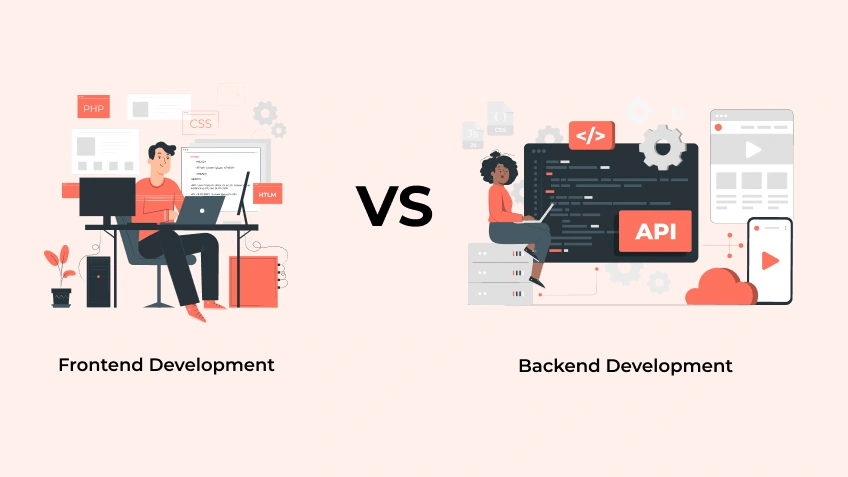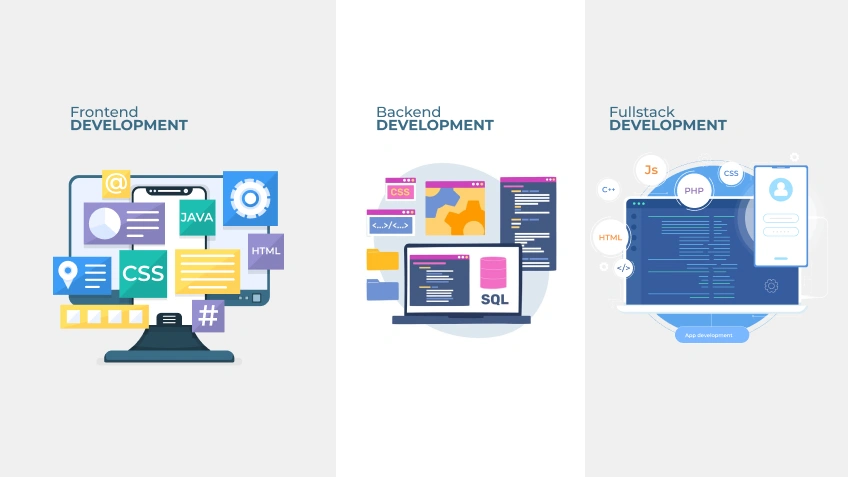By Tanmay Das

A full-stack developer is a versatile and highly valued professional. They possess the skills to navigate both the user-facing front end and the server-side back end, which opens up a wealth of opportunities. Whether you are planning for a front-end, back-end, or full-stack development career or want to deepen your understanding in the field, this blog will provide a comprehensive overview of this booming tech field.
Let’s dive in!
The year 2025 witnessed 48700 full-stack developer job openings on Naukri.com. Demand for full-stack developers has surged 30% year-on-year. This amplifying demand is fueled by the growing need for versatile developers who can adeptly handle both front-end and back-end tasks.
While aspiring to a career as a full-stack web developer is a smart move, the initial question that many face is, “Do I specialise in the user-facing front-end, the server-side back-end, or both?
“A successful website does three things:
It attracts the right kinds of visitors.
Guides them to the main services or products you offer.
Collect Contact details for future ongoing relations.” ― Mohamed Saad
This quote highlights that becoming a full-stack web developer depends on the ability to handle all aspects of web development. Engaging front-end appeals and guides users, a robust back-end system manages products and gathers valuable contact information.
If you are confused about picking one, this full-stack developer guide will illuminate your path to front-end, back-end, and full-stack web development. Get a comprehensive overview of this booming tech field and choose the one that aligns with your career goals and interests.
Let’s begin!

Front-end development is also known as client-side development. It is a process of creating a UI (user interface) and UX (user experience) for a web application or a website. The front end is everything that a website visitor or web app user sees and interacts with.
Think of front-end development as the layout of rooms, paint colours, decorations, and the furniture of a house. All these aspects not only make a house attractive but also functional for all members living inside it.
Key aspects of front-end development include:
The following table highlights key languages, frameworks, libraries, tools and technologies used in front-end web development.
| Key Languages | Frameworks and Libraries | Tools and Technologies |
|
|
|

Back-end development is also known as server-side development. It is the process of building and maintaining the back-end or behind-the-scenes functionalities of a web application or a website. It is easy to learn backend web development and begin a career in this tech field.
Think of back-end development as the foundation, electrical system, plumbing system, and structure of a house. All these factors not only make a house functional and stable but also ensure that everything inside the house is working properly. Although you don’t see these aspects directly, they have a direct impact on the house’s overall functionality.
Key aspects of back-end development include:
The following table highlights key languages, frameworks, libraries, and databases of back-end web development.
| Key Languages | Frameworks and Libraries | Databases |
|
|
|

Full-stack web development is the process of building a comprehensive web application which includes both the front end and back end. A full-stack developer is a versatile professional who possesses expertise and skills to work on every layer of the web application. Full-stack website development includes everything from the user interface to the database. Making a career in full-stack web development offers numerous perks and rapid career advancement.
Key aspects of full-stack web development include:
| Key Languages | Frameworks and Libraries | Tools and Technologies | Databases |
|
|
|
|

| Areas | Front-End | Back-End | Full-Stack Web Development |
| Technologies Used |
|
|
|
| Required Skills |
|
|
|
| Roles & Responsibilities |
|
|
|
| Learning Curve |
|
|
|
| Project Engagement |
|
|
|
| Industry Demand |
|
|
|
| Career Path |
|
|
|

While the front end and back end have key differences, both are interconnected parts of a web application. Both work together to continuously deliver the best user experience and aspects you interact with.
Here is the breakdown of how front-end and back-end collaborate:

The career path and growth for front-end, back-end, and full-stack web developers seem strong and evolving at a rapid pace. Let’s unpack each domain’s salary and career growth to gain a better understanding.
The salary of a front-end developer depends on proficiency in popular frameworks and essential skill sets like Vue.js, Angular, or React. The average salary is also influenced by the level of knowledge in UI/UX principles.
However, front-end developer salaries in India average between ₹1.2 Lakhs and ₹12.0 Lakhs per year, influenced heavily by experience and expertise.
Front-end developers can grow into roles like
The exact payscale of a backend developer depends on the expertise in server-side languages like Java, Python, Node.js and frameworks such as Express.js and Django.
The average salary is also influenced by experience, location, data management skills such as SQL and NoSQL, cloud computing knowledge and DevOps practices. However, in India, the salary of a back-end developer typically ranges from ₹1.5 Lakhs to ₹17.3 Lakhs per year.
Back-end developers can grow into roles like
Full-stack developers’ salary depends on their proficiency in both front-end and back-end technologies, the ability to handle all aspects of application development and experience in popular stacks like MEAN, MERN, Laravel, Vue.js, etc.
However, the salary of a full-stack developer in India ranges from ₹1.8 Lakhs to ₹16.0 Lakhs per year.
A full-stack developer can grow into roles like
The best choice between front-end, back-end, and full stack boils down to your career goals and passion. Demand for front-end, back-end, and full-stack developers is going strong and is expected to grow in the future. Each domain has unique challenges, career opportunities, and associated rewards.
We hope this full-stack developer guide helped you understand each domain well.
If you want to tap into this ever-evolving tech field but are wondering how to become a full-stack developer, we can help you make a career in full-stack web development.
Whether you want to become a front-end developer, excel as an expert back-end developer, or be an all-around full-stack web developer, just share your interest at +91 9836423755, and leave everything to us!
What are the technologies involved in responsive web design?
Responsive web design includes HTML for structure, CSS for different styles on diverse screens, responsive images/videos, and flexible layouts.
Is it worth learning web development in 2025 due to AI?
Absolutely! While AI (artificial intelligence) is revolutionising industries, this technology will not replace human intelligence in terms of creativity, problem-solving skills, and understanding of users’ needs. Learning web development is a valuable skill in 2025 and in the future, too.
What are the least front-end web technologies to learn for a back-end developer?
To become a back-end developer, you need to focus on the basic structure of HTML and understand the fundamentals of CSS for layout. Additionally, a basic understanding of JavaScript and how it interacts with the front-end also benefits the full application development flow.
How to become a pro front-end developer?
To become a pro front-end developer, you need to have a core understanding of languages like JavaScript, CSS, and HTML. Furthermore, you need to master a modern framework such as React, Angular, or Vue.js. Also, staying updated with the latest trends and building a robust portfolio highlighting complex projects greatly helps you attain this career goal.
How to become a full-stack developer?
To become a full-stack developer, you require expertise in both front-end (HTML, CSS, JavaScript and frameworks like React or Angular) and back-end technologies (Node.js, Python, or Java, and databases). You can learn these technologies and become a certified full-stack developer in 6 months through our IIT Guwahati certified full stack web development program.
What types of projects should a beginner web developer create?
If you are a beginner web developer, you should start with simple projects such as landing pages, personal websites, basic calculators, personal websites, etc. This helps in solidifying all foundational concepts.
Which is better, frontend or backend?
Both the front end and back end are different but very crucial parts of web development. While the front end focuses on user experiences, the back end handles data and functionality. The better career choice depends on your interests and skills.
Who earns more, full-stack developers or front-end developers?
Full-stack developers earn comparatively more than front-end developers as they can seamlessly handle all aspects of web development.